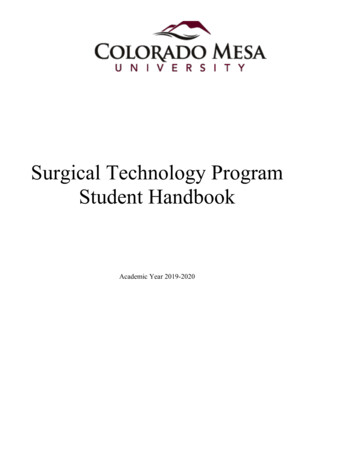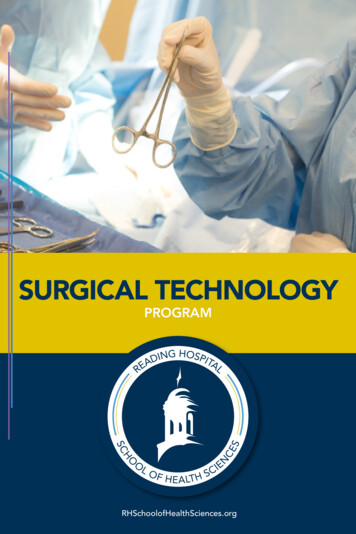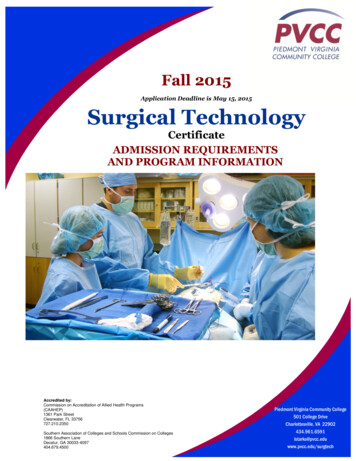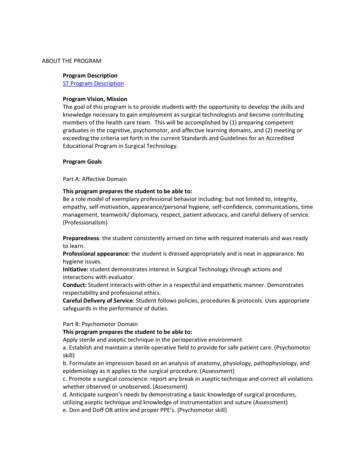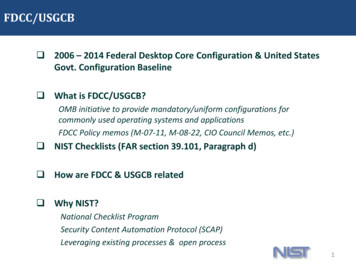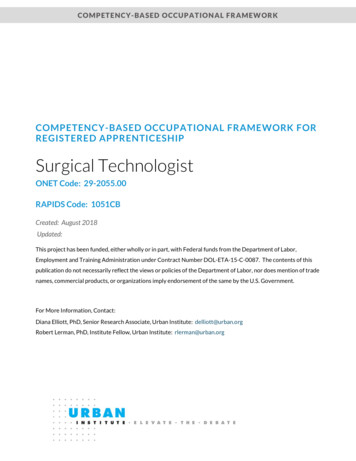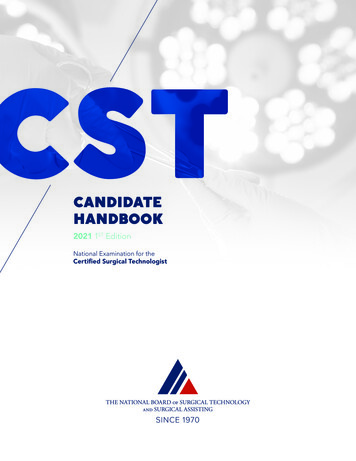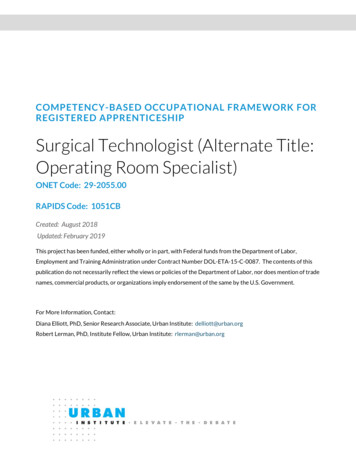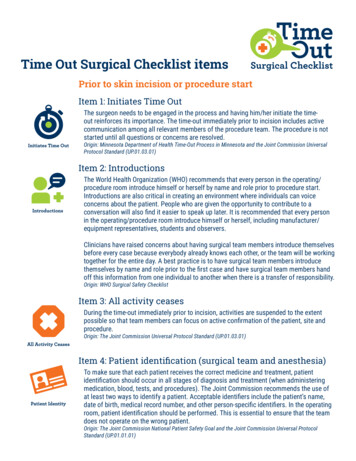
Transcription
Time Out Surgical Checklist itemsPrior to skin incision or procedure startItem 1: Initiates Time OutThe surgeon needs to be engaged in the process and having him/her initiate the timeout reinforces its importance. The time-out immediately prior to incision includes activecommunication among all relevant members of the procedure team. The procedure is notstarted until all questions or concerns are resolved.Origin: Minnesota Department of Health Time-Out Process in Minnesota and the Joint Commission UniversalProtocol Standard (UP.01.03.01)Item 2: IntroductionsThe World Health Organization (WHO) recommends that every person in the operating/procedure room introduce himself or herself by name and role prior to procedure start.Introductions are also critical in creating an environment where individuals can voiceconcerns about the patient. People who are given the opportunity to contribute to aconversation will also find it easier to speak up later. It is recommended that every personin the operating/procedure room introduce himself or herself, including manufacturer/equipment representatives, students and observers.Clinicians have raised concerns about having surgical team members introduce themselvesbefore every case because everybody already knows each other, or the team will be workingtogether for the entire day. A best practice is to have surgical team members introducethemselves by name and role prior to the first case and have surgical team members handoff this information from one individual to another when there is a transfer of responsibility.Origin: WHO Surgical Safety ChecklistItem 3: All activity ceasesDuring the time-out immediately prior to incision, activities are suspended to the extentpossible so that team members can focus on active confirmation of the patient, site andprocedure.Origin: The Joint Commission Universal Protocol Standard (UP.01.03.01)Item 4: Patient identification (surgical team and anesthesia)To make sure that each patient receives the correct medicine and treatment, patientidentification should occur in all stages of diagnosis and treatment (when administeringmedication, blood, tests, and procedures). The Joint Commission recommends the use ofat least two ways to identify a patient. Acceptable identifiers include the patient’s name,date of birth, medical record number, and other person-specific identifiers. In the operatingroom, patient identification should be performed. This is essential to ensure that the teamdoes not operate on the wrong patient.Origin: The Joint Commission National Patient Safety Goal and the Joint Commission Universal ProtocolStandard (UP.01.01.01)
Item 5: Procedure and siteVerifying the site of the surgery is essential to ensure that the team performs the correctprocedure on the correct site. This process step is an opportunity to confirm the operativesite with the patient and team.Origin: The Joint Commission National Patient Safety Goal and the Joint Commission Universal ProtocolStandard (UP.01.02.01)Surgical team members should always make certain that any procedure is what the patientneeds and is performed on the right person. Verifying the surgical procedure and consent isan ongoing process of information gathering and confirmation and is initially confirmed inthe preoperative area by multiple team members.This check is the last opportunity to verify with the patient and team that the consent isconsistent with the patient’s expectations and the team’s understanding of the procedure tobe performed. It provides an important opportunity to address any questions, concerns, ordiscrepancies prior to induction of anesthesia. This step should include the surgeon and/orscrub nurse or technician if they are present.Origin: South Carolina Safe Surgery 2015Item 6: Patient identification (anesthesia care provider)To make sure that each patient receives the correct medicine and treatment, patientidentification should occur in all stages of diagnosis and treatment (when administeringmedication, blood, tests, and procedures). The Joint Commission recommends the use ofat least two ways to identify a patient. Acceptable identifiers include the patient’s name,date of birth, medical record number, and other person-specific identifiers. In the operatingroom, patient identification should be performed. This is essential to ensure that the teamdoes not operate on the wrong patient.Origin: The Joint Commission National Patient Safety Goal and the Joint Commission Universal ProtocolStandard (UP.01.01.01)Item 7: Site marking confirmationVerifying correct site marking in the operating/procedure room is a step for the patient andteam to assure that the correct operative site is marked. Each facility has procedures formarking of the incision or insertion site. At minimum, a site should be marked when thereis more than one possible location for the procedure and when performing the procedure ina different location. For spinal procedures, in addition to preoperative skin marking of thegeneral spinal region, special intraoperative imaging techniques may be used for locatingand marking the exact vertebral level. Site marking must occur before the procedure isperformed and with the patient awake and involved (if possible). The site should be markedby a licensed independent practitioner who is ultimately accountable for the procedure andwho will be present when the procedure is performed. The method of marking the site andthe type of mark should be unambiguous and used consistently throughout the hospital.The mark should be made at or near the incision/insertion site and needs to be sufficientlypermanent to be visible after the skin is prepped and draped.Origin: The Joint Commission National Patient Safety Goal Universal Protocol (UP.01.02.01)
Item 8: Procedure from memoryDuring 2008, the Minnesota Department of Health (MDH) contracted with the Universityof Minnesota to strengthen presurgical verification procedures. As part of this project, ahuman factors researcher recommended process changes designed to cognitively engageeach member of the team in order to create a more robust and effective safe surgeryprocess. The recommendations also address human factors issues such as cognitiveoverload, faulty risk perception, cultural issues/hierarchies, confirmation bias, and theimpact of distractions on behaviors.Origin: Minnesota Department of Health Time-Out Process in Minnesota, 2008Item 9: Culture statementThis item is sometimes referred to as “the surgeon safety statement.” When the surgeoninvites other surgical team members to speak up, she or he sets a positive a tone inthe operating room, creates a sense of openness, and encourages everyone in theoperating room to be comfortable voicing concerns during the case. Universal Protocol isimplemented most successfully in hospitals with a culture that promotes teamwork andwhere all individuals feel empowered to protect patient safety. A hospital should considerits culture when designing processes to meet the Universal Protocol.Origin: Safe Surgery ChecklistPrior to skin incision/start of procedure or beforeinduction of anesthesiaItem 10: Bio specimen planSeveral simple steps can be taken to minimize the risk of mislabeling. First, the patientfrom whom each surgical specimen is taken should be identified with at least twoidentifiers (e.g. name, date of birth, medical record number). Second, the nurse shouldreview the specimen details with the surgeon by reading aloud the name of the patientlisted and the name of the specimen, including the site of origin and any orientingmarkings. When required by a facility, the surgeon should complete a requisition formlabelled with the same identifiers as the specimen container.Origin: WHO Guidelines for Safe Surgery 2009Item 11: ImagingThe WHO Surgical Safety Checklist recommends reviewing essential imaging if it isneeded during the procedure. Imaging should be prominently displayed for use during theoperation. If imaging is needed but not available, it should be obtained before skin incision.It is important that this discussion occurs at a time when the surgeon is present.Origin: WHO Surgical Safety ChecklistItem 12: Procedure set-upThe Universal Protocol is non-prescriptive on the specific roles of team members and theorder in which they should confirm the information provided by the initiator of the preprocedure or time-out discussions. The Minnesota Department of Health Time-Out Processin Minnesota provides direction to facilities about the information that each team memberis expected to provide. The expectation for each team member should be tailored to his/herrole on the team and the information that he/she is likely to have. For example, the scrubtech who would be involved in setting up equipment and supplies for the procedure is theideal person to confirm the procedure for which he/she has set up.Origin: Minnesota Department of Health Time-Out Process in Minnesota, 2008
Item 13: Operative planThis item prompts the surgeon to share a summary of the operative plan for the patientwith all surgical team members.Important details of the procedure to be performed are often known only to the surgeon,even though the team is usually aware of the type of procedure. This item gives thesurgeon the opportunity to share this information, which in turn helps facilitate the team’sperformance. If the plan is routine, the surgeon may state “routine procedure.”The surgeon may discuss possible difficulties, expected duration, anticipated blood loss,and whether special equipment is required as part of the operative plan.Origin: WHO Surgical Safety ChecklistItem 14: Anesthetic planThe WHO Surgical Safety Checklist recommends that the anesthesia professional sharethe anesthetic plan, particularly any concerns with major morbidities. Discussing theanesthetic plan helps ensure that team members are adequately prepared and ready toanticipate potential risks.Origin: WHO Surgical Safety ChecklistItem 15: Airway concernsThe WHO Surgical Safety Checklist recommends that the anesthesia professional shareany concerns about the patient’s airway, to alert all teams members about possiblecomplications. If no problems are expected, the anesthesia professional may report “noairway risks or concerns.”Origin: WHO Surgical Safety ChecklistItem 16: Code statusOnce a decision is reached on the patient’s DNR status as a result of the requiredreconsideration conversation, the surgeon must continue his or her leadership role inthe following areas: (1) documenting and conveying the patient’s advance directiveand DNR status to the members of the operating room team; (2) helping the operatingroom team members understand and interpret the patient’s advance directive; and (3) ifnecessary, finding an alternate team member to replace an individual who has an ethical orprofessional conflict with the patient’s advance directive instructions.Origin: American College of Surgeons: Statement on Advance Directives by Patients: "Do Not Resuscitate" in theOperating Room, January 3, 2014Item 17: Fire risk scoreHealth care professionals and staff who perform surgical procedures should be trainedin practices to reduce surgical fires. Training should include factors that increase the riskof surgical fires, how to manage fires that do occur, periodic fire drills, how to use carbondioxide (CO2) fire extinguishers near or on patients, and evacuation procedures. Specificrecommendations to reduce surgical fires include: conducting a fire risk assessment atthe beginning of each surgical procedure and encouraging communication among surgicalteam members—ensure communication exists between the anesthesia professionaldelivering medical gases, the surgeon controlling the ignition source, and the operatingroom staff applying skin preparation agents and drapes.Origin: Recommendations to Reduce Surgical Fires and Related Patient Injury: FDA Safety Communication, May28, 2018
Item 18: Antibiotic prophylaxisThis item prompts confirmation that antibiotics are fully infused prior to skin incision. Apatient’s risk of developing a surgical site infection is reduced if prophylactic antibiotics areinfused within one hour prior to surgical incision.Origin: WHO Surgical Safety ChecklistFor cases that are going to last longer than three hours, a plan for antibiotic redosingshould be discussed.Origin: South Carolina Safe Surgery 2015Item 19: Other concerns (ACP)The WHO Surgical Safety Checklist recommends building in an opportunity for theanesthesia professional to raise any other concerns that they might have. Sometimespeople won’t share concerns unless they are given the specific opportunity to do so.Origin: WHO Surgical Safety ChecklistItem 20: Implants & special equipmentThis item prompts a discussion of implants or special equipment that is required andhelps the team adequately prepare and anticipate needs for the procedure. Discussingappropriate implants or equipment has been shown to decrease the number of times thecirculator leaves the room and ultimately decreases room time.Origin: WHO Surgical Safety ChecklistItem 21: Equipment issuesThe WHO Surgical Safety Checklist recommends that the nursing team discuss anyequipment problems or concerns to adequately prepare and anticipate needs for theprocedure. This is another opportunity for the nursing and technology team to discussequipment problems or ask questions regarding the surgical team’s anticipated needs.Adequate preparations for the procedure reduce wait time in the operating/procedure roomand help reduce the need for the circulating nurse to leave the room during surgery.Origin: WHO Surgical Safety ChecklistItem 22: Other concerns (circulator, scrub or othertechnologist)The WHO Surgical Safety Checklist recommends building in an opportunity for thecirculating nurse, scrub nurse, or technologist to ask other questions or express concerns.Sometimes people won’t share concerns unless they are given the specific opportunity todo so.Origin: WHO Surgical Safety Checklist
identifiers (e.g. name, date of birth, medical record number). Second, the nurse should review the specimen details with the surgeon by reading aloud the name of the patient listed and the name of the specimen, including the site of origin and any orienting markings. When required by a facility, the surgeon should complete a requisition form
